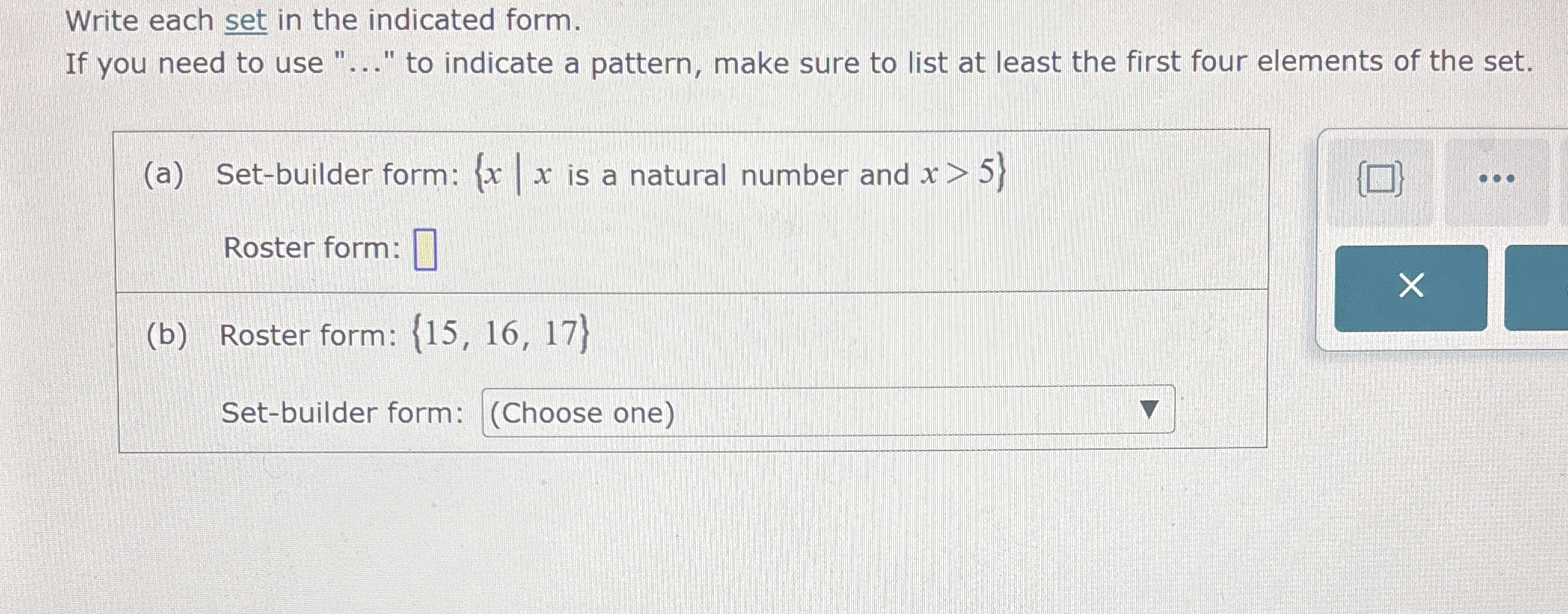Write each set in the indicated form. (a) Set-builder form: {x | x is a natural number and x > 5}. Roster form: ? (b) Roster form: {15, 16, 17}. Set-builder form: ?

Understand the Problem
The question asks to convert between set-builder notation and roster notation. Part (a) provides the set in set-builder notation and asks for the equivalent roster notation. Part (b) provides the roster notation and asks for the equivalent set-builder notation.
Answer
(a) $\{6, 7, 8, 9, ...\}$ (b) $\{x \ | \ x \text{ is a natural number and } 14 < x < 18 \}$
Answer for screen readers
(a) ${6, 7, 8, 9, ...}$ (b) ${x \ | \ x \text{ is a natural number and } 14 < x < 18 }$
Steps to Solve
- Convert set-builder to roster notation for part (a)
The set-builder notation ${x \ | \ x \text{ is a natural number and } x > 5}$ describes all numbers $x$ such that $x$ is a natural number and $x$ is greater than 5. Natural numbers are positive integers (1, 2, 3,...). Therefore, we need to list all natural numbers greater than 5. Since the set is infinite, we will use "..." to show the continuing pattern. We need to list at least the first four elements.
- Write the roster notation for part (a)
The roster notation is ${6, 7, 8, 9, ...}$.
- Convert roster to set-builder notation for part (b)
We need to look for a property that 15, 16, and 17 have in common. We can describe them as natural numbers between 14 and 18, not inclusive.
- Write the set-builder notation for part (b)
The set-builder notation is ${x \ | \ x \text{ is a natural number and } 14 < x < 18 }$.
(a) ${6, 7, 8, 9, ...}$ (b) ${x \ | \ x \text{ is a natural number and } 14 < x < 18 }$
More Information
Set-builder notation provides a rule for determining the elements of a set, while roster notation explicitly lists the elements.
Tips
A common mistake in part (a) is not including enough elements before the ellipsis (...). The question specifies listing at least the first four elements to establish the pattern. Another mistake is including 5, as the condition specifies $x > 5$, not $x \geq 5$. A common mistake in part (b) is writing the bounds incorrectly. For example, writing $15 \leq x \leq 17$ instead of $14 < x < 18$.
AI-generated content may contain errors. Please verify critical information